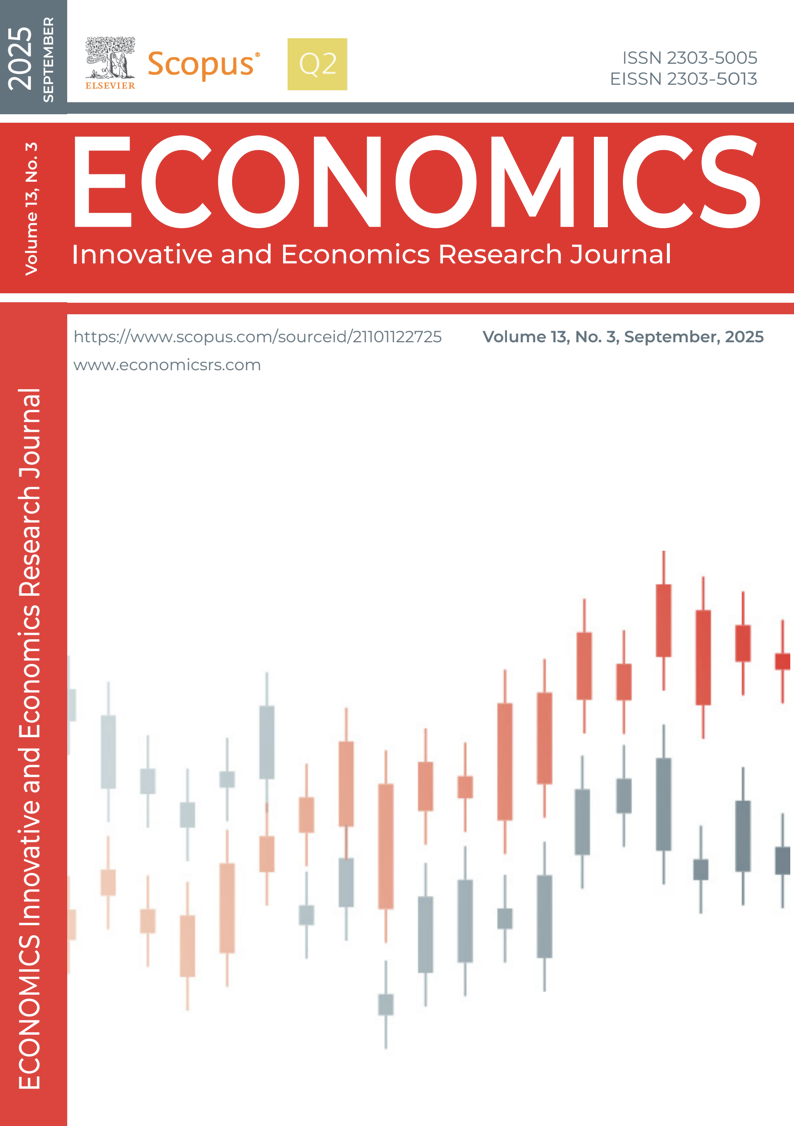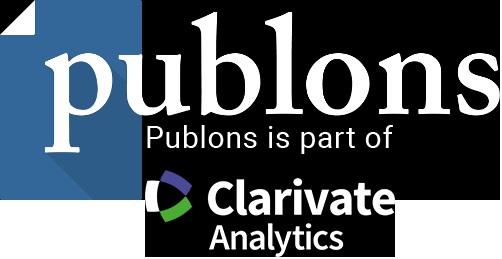CREATIVE ECONOMY AT THE NEXUS OF INNOVATION, DIGITALIZATION AND EDUCATION: ARDL AND NARDL APPROACH FROM KAZAKHSTAN
DOI:
https://doi.org/10.2478/eoik-2025-0060Keywords:
female employment, economic growth, birth rate, digitalization, ARDLAbstract
The purpose of the research work is to assess the indicators of innova-
tion, digitalization and knowledge that have an impact on the creative
economy. For this purpose, the following indicators were analyzed: to-
tal GVA for the creative industry, the share of GVA for the creative in-
dustry in GDP, government expenditure on education, research and de-
velopment expenditure, information technology exports, internal R&D
costs by branches of science, the volume of innovative products (goods,
services), and the share of innovative products (goods, services). The
data covers the period 2004-2022 and is taken from global and domes-
tic data sources. In order to obtain comprehensive results of the study,
two models were used: Linear Autoregressive Distributed Lag (ARDL)
and Non-Linear Autoregressive Distributed Lag (NARDL). According
to the results of the model, indicators with linear and nonlinear effects
in the long and short term were identified. The practical significance
of the study lies in the finding that the negative impact of internal Re-
search and Development indicates the need to strictly monitor the prog-
ress and results of funds allocated to this sector and scientific projects.
Although government spending on education has negative effects in
the short term, it has positive effects in the strategic long run. It is im-
portant to highlight that for Kazakhstan, it is high priority to support
creative economy sectors that have practical importance and result in
production. The study also adds new empirical evidence and extends
the existing literature on the creative economy.
References
ALIMI, R. (2014). ARDL Bounds Testing Approach to Cointegration: A Re-Examination of Augmented
Fisher Hypothesis in an Open Economy. Asian Journal of Economic Modelling. 2. 103-114.
https://doi.org/10.18488/journal.8.2014.22.103.114
Ahmed, Sabahat & Meraj, Muhammad & Khan, Afaq & Ali, Ashfaq. (2024). Impact of Research and
Development Expenditures on Economic Growth: Evidence from Industrial Development in
Pakistan and A Comparison from Developed Countries. Pakistan Journal of Humanities and
Social Sciences. 12. 2098-2109. https://doi.org/10.52131/pjhss.2024.v12i2.2376
Akaike, H. (1974) A New Look at the Statistical Model Identification. IEEE Transactions on Automatic
Control, AC- 19, 716-723. http://dx.doi.org/10.1109/TAC.1974.1100705
Ali, T. M., Kausar Kiani, A., Bashir, T., & Khan, T. N. (2021). R&D Expenditure as an Accelerator of
Economic Growth with Special Reference to Developing Countries. Journal of Business and
Social Review in Emerging Economies, 7(3), 561-589. https://doi.org/10.26710/jbsee.v7i3.1842
Amory, Jeffriansyah. (2024). Creative Economy as a Catalyst for Change: A New Strategy to Alleviate
Rural Poverty. Indo-Fintech Intellectuals: Journal of Economics and Business. 4. 2732-2746.
https://doi.org/10.54373/ifijeb.v4i5.2189
Argynbekov, Maxat & zeynelgabdin, Altay. (2024). Issues of development of the creative economy in
the republic of kazakhstan. Public Administration and Civil Service. 91. 86-105. https://doi.
org/10.52123/1994-2370-2024-1242
Baitenizov, Daniyar & Dubina, Igor & Campbell, David & Carayannis, Elias & Azatbek, Tolkyn. (2019).
Freelance as a Creative Mode of Self-employment in a New Economy (a Literature Review).
Journal of the Knowledge Economy, 10. https://doi.org/10.1007/s13132-018-0574-5
Bolatbek, Y., Niyetalina, G., Garcia Laborda, J., & Akhmetova, Z. (2024). The role of marketing and
advertising in the integration and development of creative industries in the international classifi-
cation. Journal of Economic Research &Amp; Business Administration, 150(4), 79–90. https://
doi.org/10.26577/be.2024.150.i4.a6
Breusch, T. S. (1978). Testing for autocorrelation in dynamic linear models. Australian Economic Pa-
pers, 17(31), 334–355. https://doi.org/10.1111/j.1467-8454.1978.tb00635.x
Breusch, T.S. and Pagan, A.R. (1979) A Simple Test for Heteroscedasticity and Random Coefficient
Variation. Econometrica, 47, 1287-1294. http://dx.doi.org/10.2307/1911963
Bridgstock, Ruth & Hearn, Greg. (2012). A conceptual model of capability learning for the twen-
ty-first-century knowledge economy. Handbook on the Knowledge Economy, Volume Two. 105-
https://doi.org/10.4337/9781781005132.00015
Brizhak, Olga & Polyakov, Ruslan. (2022). Creative Impetus for the Development of Innovation Clus-
ters of the Russian Economy. https://doi.org/10.1007/978-3-031-05778-6_10
Brown, R. L., Durbin, J., & Evans, J. M. (1975). Techniques for Testing the Constancy of Regression
Relationships over Time. Journal of the Royal Statistical Society. Series B (Methodological),
(2), 149–192. http://www.jstor.org/stable/2984889
Bulochnikov, P. & Evmenov, A. (2025). Creative industries as a factor in the socio-economic develop-
ment of the Northwestern Federal District in the context of digital transformation. Economics
and Management. 30. 1455-1473. https://doi.org/10.35854/1998-1627-2024-12-1455-1473
Creative Economy Outlook (2024). UN Trade and Development, https://doi.org/10.18356/9789211065558
Dickey, D. A., & Fuller, W. A. (1979). Distribution of the Estimators for Autoregressive Time Series
with a Unit Root. Journal of the American Statistical Association, 74(366), 427–431. https://doi.
org/10.2307/2286348
Dzhakisheva. У., Cherep А., Kanabekova М., & Meldebekova А. (2024). Creative economy as a key
to solving economic issues of modern society. Journal of Economic Research &Amp; Business
Administration, 2(148), 32–42. https://doi.org/10.26577/be.2024-148-b2-03
Fahmi, F. Z., McCann, P., & Koster, S. (2017). Creative economy policy in developing countries: The
case of Indonesia. Urban Studies, 54(6), 1367–1384. https://www.jstor.org/stable/26151420
Akhmetova Z. et al. / Economics - Innovative and Economics Research Journal, doi: 10.2478/eoik-2025-0060
Feher, Katalin & Junaidy, Deny & Larasati, Dwinita & Kovacs, Agnes & Rahardjo, Budi. (2017). Cre-
ative Industries and Digital Economy – Perspectives from Southeast Asia and Central Europe.
https://www.academia.edu/34399803/Creative_Industries_and_Digital_Economy_Perspec-
tives_from_Southeast_Asia_and_Central_Europe
Florida, Richard. (2003). THE Rise of the Creative Class: And How It’s Transforming Work, Leisure,
Community and Everyday Life. Canadian Public Policy / Analyse de Politiques, 29. https://doi.
org/10.2307/3552294
Godfrey, L. G. (1978). Testing Against General Autoregressive and Moving Average Error Models when
the Regressors Include Lagged Dependent Variables. Econometrica, 46(6), 1293–1301. https://
doi.org/10.2307/1913829
Goel, R. K., & Ram, R. (1994). Research and Development Expenditures and Economic Growth: A
Cross-Country Study. Economic Development and Cultural Change, 42(2), 403–411. http://
www.jstor.org/stable/1154449
Haroon, S. & Zeeshan, Q. (2023). The Impact of the COVID-19 Pandemic on Software Business Enter-
prises in Pakistan: Analysis and Implications. Journal of Engineering Management and Systems
Engineering, 2(2), 123-133. https://doi.org/10.56578/jemse020204
Hidayati, Abna & Bentri, Alwen & Sunarti, Vevi & Cerya, Efni. (2022). Development of Digitalization
Program And Establishment of Creative Economic Centers at The Nagari Assistant of UNP In
Bisati Padang Pariaman District West Sumatera. Kolokium Jurnal Pendidikan Luar Sekolah, 10.
-174. https://doi.org/10.24036/kolokium.v10i2.536
Howkins, John. (2002). The Creative Economy: How People Make Money from Ideas. https://archive.
org/details/creativeeconomyh0000howk_k3z2/mode/1up?utm_source=chatgpt.com
Istudor, L. G. (2018). Innovation and entrepreneurship in Romania’s cultural and creative industries.
Proceedings of the International Conference on Business Excellence, 12(1), 498–507. https://
doi.org/10.2478/picbe-2018-0045
Ivaschenko, Oleksiy, and Shanti Jagannathan. (2025). A review of digital creative industries in Asia:
opportunities and policies to foster growth and create high-quality jobs. Manila: Asian Devel-
opment Bank. http://dx.doi.org/10.22617/TCS240434-2
Jarque, C. M., & Bera, A. K. (1980). Efficient tests for normality, homoscedasticity and serial indepen-
dence of regression residuals. Economics Letters, 6(3), 255–259. https://doi.org/10.1016/0165-
(80)90024-5
Kalenyuk, Iryna & Kuznetsova, Nataliya. (2022). Creative Economy in the Global Innovation Process.
Міжнародна економічна політика. 101-123. https://doi.org/10.33111/iep.2022.36.05
Kalın, F. (2023). R&D Expenditures and Economic Growth: A Panel Data Analysis For Selected Devel-
oping Economies. Industrial Policy, 3(2), 39-46. https://doi.org/10.61192/indpol.1331487
Kichurchak, Marianna. (2023). Information and communication technologies sector development as a
factor of forming creative industries in the european union countries: experience of the structur-
al transformation for ukraine. Financial and credit activity problems of theory and practice. 1.
–408. https://doi.org/10.55643/fcaptp.1.48.2023.3934
Knell, J., & Oakley, K. (2007). London’s Creative Economy: An Accidental Success? https://creativein-
dustrieslondon.wordpress.com/wp-content/uploads/2014/11/accidental-success-1.pdf
Ljung, G. M., & George E. P. Box. (1979). The Likelihood Function of Stationary Autoregressive-Mov-
ing Average Models. Biometrika, 66(2), 265–270. https://doi.org/10.2307/2335657
Lupu, R., Komorowski, M., Lewis, J., & Fodor, M.M. (2025). Research, Development and Innovation
in the Creative Industries: Reframing Our Understanding of the Creative Economy (1st ed.).
Routledge. https://doi.org/10.4324/9781003481805
Lyck, L. (2013). Innovation and “Creative Economy”. Paper presented at The 6th International Confer-
ence on Baltic Sea Parliamentary Cooperation, Berlin, Germany. https://research-api.cbs.dk/ws/
portalfiles/portal/58852656/Lyck_1_.pdf
Creative Economy at the Nexus of Innovation, Digitalization and Education: Ardl and Nardl Approach from Kazakhstan
Maia, A. L. M. D. & Frogeri, R. F. (2023). Optimizing Business Value via It Governance Mechanisms:
An Examination of SMEs in Southern Minas Gerais, Brazil. Journal of Operational and Strate-
gic Analytics, 1(3), 106-114. https://doi.org/10.56578/josa010301
Mann, L., & Chan, J. (Eds.). (2011). Creativity and Innovation in Business and Beyond: Social Science Per-
spectives and Policy Implications (1st ed.). Routledge. https://doi.org/10.4324/9780203833063
Martial, Tri & Pasha, T. & Badrudin, Rudy & Sitompul, Gabriel. (2024). Creative Economy as a Driver
of Economic Growth in the Digital Era. Nomico. 1. 8-15. https://doi.org/10.62872/t2w8cy65
Matthews, M. Science and Innovation Policy and the New (and Old) Economics of Creativity. Cultural
Science, 2008, Sciendo, vol. 1 no. 1, https://doi.org/10.5334/csci.8
Maulina, R. (2020). Innovation and creativity as capital in the creative economy sector. In Proceedings
of the International Conference on Business, Economic, Social Science, and Humanities – Hu-
manities and Social Sciences Track (ICOBEST-HSS 2019), 127–130. Atlantis Press. https://doi.
org/10.2991/assehr.k.200108.026
Moussir, C.E. (2025). Morocco’s Economic Prospects: A Dynamic ARDL Simulation on Global Value
Chain Integration. Economics - innovative and economics research journal, 13(1), 179–196.
https://doi.org/10.2478/eoik-2025-0009
Muchira, John. (2023). Digital media and creative economy potential on youth employment in Ken-
ya: a grounded theory perspective. Information and Learning Sciences. 124. 10.1108/ILS-
-2022-0043. Creative Economy Outlook (2024). UN Trade and Development, https://doi.
org/10.18356/9789211065558
Nurumov, Aldanysh. (2023). Strategic Guidelines for the Development of Small and Medium-sized
Businesses: Evidence of Kazakhstan. Montenegrin Journal of Economics. 19. https://doi.
org/10.14254/1800-5845/2023.19-4.15
Panjawa, Jihad & Ratnasari, Emma & Hutajulu, Dinar & Samsudin, Mohamad & Lestari, Puji & Er-
nawati, Dhanik & Purna, Fitra. (2024). Investigating the Key Drivers of Career Selection in
the Creative Economy Sector. Jurnal Ekonomi Pembangunan: Kajian Masalah Ekonomi dan
Pembangunan, 315-338. https://doi.org/10.23917/jep.v25i2.24066
Pesaran, M. H., Shin, Y., & Smith, R. J. (2001). Bounds Testing Approaches to the Analysis of Level Rela-
tionships. Journal of Applied Econometrics, 16(3), 289–326. http://www.jstor.org/stable/2678547
Polishchuk, O. & Gracheva, N. & Dushkina, V. & Kovaleva, M. (2025). The state and development trends
of the creative economy. Proceedings of the Southwest State University. Series: Economics. So-
ciology. Management. 14. 105-119. https://doi.org/10.21869/2223-1552-2024-14-6-105-119
Potts, Jason & Cunningham, Stuart. (2008). Four Models of the Creative Industries. Revue d’économie
politique. Volume 120. 163-180. https://doi.org/10.1080/10286630802281780
Saehu, Muhammad & Ansori, Ansori & Suharto, Suharto & Purnamasari, Desy & Simbolon, Gallex. (2023).
Realizing the Narrative: Higher Education Strategies as Creative Economy Agents in Indonesia.
AL-ISHLAH: Jurnal Pendidikan, 15. 1471-1479. https://doi.org/10.35445/alishlah.v15i2.3079
Santos Vieira de Jesus, Diego. (2019). The unfulfilled promise of education for creative economy in
Brazil. International Journal of Innovation Education and Research, 7. 146-156. https://doi.
org/10.31686/ijier.Vol7.Iss5.1485
Saparova, N., Kireyeva, A., Orynbet, P., Alimbekova, G., & Amirova, A. (2023). Analysis of the de-
velopment level of higher educational institutions in the regions of Kazakhstan. Management,
(2), 244-256. http://dx.doi.org/10.21511/ppm.21(2).2023.26
Sava, Diana Cristina & Badulescu, Alina. (2016). Implications of the creative economy: cultural employ-
ment. Emerging Markets Economics and Business. Contributions of Young Researchers. Pro-
ceedings of the 7th Conference of Doctoral Students in Economic Sciences, 4. 166 - 169. https://
www.researchgate.net/publication/316880176_IMPLICATIONS_OF_THE_CREATIVE_
ECONOMY_CULTURAL_EMPLOYMENT
Serikkyzy, A. & Baktymbet, A. & Baktymbet, S. & Dadabayeva, D. (2023). Digital technolo-
gy and development of creative industry. Bulletin of Turan University. 188-199. https://doi.
org/10.46914/1562-2959-2023-1-4-188-199
Akhmetova Z. et al. / Economics - Innovative and Economics Research Journal, doi: 10.2478/eoik-2025-0060
Setiawati, Rini & Mubasit, & Hidayat, Rahmat. (2023). Digitalization in Promoting Women’s Empow-
erment and a Post-Pandemi Creative Economy. West Science Journal Economic and Entrepre-
neurship, 1. 209-218. https://doi.org/10.58812/wsjee.v1i03.156
Shevchenko, I. (2023). A Methodical Approach to Determining the Level of Development of Digital Trade in
Global Markets. Collection of papers new economy, 196-216. https://doi.org/10.61432/CPNE0101196s
Shkarina, Vera. (2024). Intellectual Capital and Management System in Creative Economy Organiza-
tions. Public Administration. E-journal (Russia). 103-115. https://doi.org/10.55959/MSU2070-
-106-2024-103-115
Skippington, P. (2016). Innovation and Creativity as Drivers of Contemporary Society. In Harnessing
the Bohemian: Artists as innovation partners in rural and remote communities, 67–90. ANU
Press. http://www.jstor.org/stable/j.ctt1q1crpj.11
Sukomardojo, Tekat & Anwar, Fahrizal & Djalipa, Dedi & Barki, Khotimatul & Zainurossalamia
Za, Saida. (2023). Creative economy branding: conquering markets through innovation and
brand excellence. Branding Jurnal Manajemen dan Bisnis, 2, 54-64. https://doi.org/10.15575/
jb.v2i1.29165
Temerbulatova, Zhansaya & Zhuparova, Aziza & Nussyupayeva, Aygerim. (2021). Statistics in the field
of creative industries: review of methodological basis. The economy: strategy and practice, 15,
-140. https://doi.org/10.51176/JESP/issue_4_T12
Toni, N. (2025). Supply Chain Sustainability and Financial Performance: The Role of E-Commerce,
Digital Banking and Digital Marketing of SMEs. Economics - innovative and economics re-
search journal, 13(1), 487–507. https://doi.org/10.2478/eoik-2025-0027
Tung, L.T. and Hoang, L. N. (2024), Impact of R&D expenditure on economic growth: evidence from
emerging economies, Journal of Science and Technology Policy Management, 15(3), 636-654.
https://doi.org/10.1108/JSTPM-08-2022-0129
UK Department of Culture, Media and Sport & Creative Industries Taskforce. (1998). Creative Indus-
tries 1998: Mapping Documents. London, UK: DCMS. http://www.creativitycultureeducation.
org/creative-industries-mapping-document-1998
Umiyati, Etik & Zevaya, Faradina & Syaparuddin. (2023). Digitalization of Creative Economy Subsec-
tors in Southern Sumatra (A Macro Quantıtatıve Analysıs Approach – Dıgıtal Entrepreneurshıp
Academy Survey). Global Conference on Business and Social Sciences Proceeding, 15, 38-38.
https://doi.org/10.35609/gcbssproceeding.2023.1(38)
Ummul Hidayah, Debby & Kusuma, Tyas & Nurhayati, Septi & Rachmandha, Fajri & Fadilah, Astrid-
itiya. (2024). Knowledge Management System to Increase Sharing of Knowledge of Creative
Economy Products. SISTEMASI, 13, 2661. https://doi.org/10.32520/stmsi.v13i6.4681
Veselá, Dagmar & Klimová, Katarína. (2014). Knowledge-based Economy vs. Creative Economy. Pro-
cedia - Social and Behavioral Sciences, 141. https://doi.org/10.1016/j.sbspro.2014.05.072
Vlasenko, T. (2023). Dimensions of the Analysis of the Organizational Culture of Multinational Compa-
nies. Collection of papers new economy, 1, 110-125. https://doi.org/10.61432/CPNE0101110v
Vlasenko, Tetiana & Pozniak, Mariana. (2020). Digitalization in creative industry for skill development.
Young Scientist, 10. https://doi.org/10.32839/2304-5809/2020-10-86-3
Yusri, M., Cemda, A. R., & Siregar, S. (2022). Empowering Regional Development with Quadruple
Helix Creative Industry Model. Journal of Urban Development and Management, 1(1), 17-25.
https://doi.org/10.56578/judm010103
Zhao X, Shen L, Jiang Z (2024) The impact of the digital economy on creative industries development:
Empirical evidence based on the China. PLoS ONE 19(3): e0299232. https://doi.org/10.1371/
journal.pone.0299232
Zhuparova, A. & Asilova, A. & Isataeva, G. (2023). Education as a factor in the development of a cre-
ative economy: a scientific synthesis of research evaluation. Central Asian Economic Review.
Downloads
Published
How to Cite
Issue
Section
License
Copyright (c) 2025 ECONOMICS - INNOVATIVE AND ECONOMICS RESEARCH JOURNAL

This work is licensed under a Creative Commons Attribution-NonCommercial-NoDerivatives 4.0 International License.























